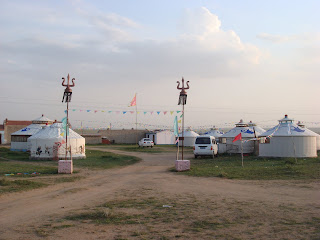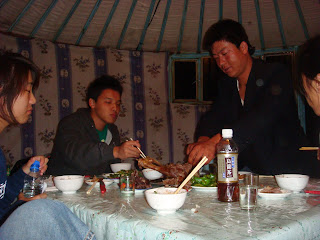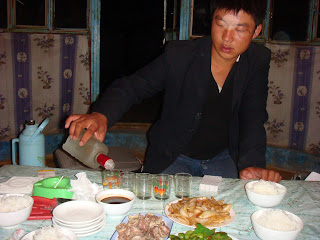 Inner Mongolia
Inner Mongolia, as opposed to
Outer Mongolia, is actually an autonomous region in northern China with its capital in
Hohhot. The majority of its population is Han Chinese and about 17% of the population is ethnic Mongolian. It is also is the hometown of Genghis Khan. Inner Mongolia is known for its vast grasslands and 蒙古包(Mogolian Huts). And lastly...it is one place you should not miss when you visit China!
So, in the summer of 2008, after getting caught up in the Olympic hype and scalping of tickets in the Beijing Olympics, me and 3 other friends decided to take the 12hr train ride from Beijing to Hohhot.
As soon as we got off the train, we were greeted from left to right by endless and endless mobs of tour agents vying for our business. We quickly stormed out of the train station to get away from the mob but knowing that we were foreigners, many of them hastily followed in our footsteps. We pulled out our savior, Lonely Planet, to pinpoint the places we wanted to go to. As soon as we finished deciding, we headed over to a nearby supermarket to stack up on snacks and drinks for our long journey. Equipped with food and drinks and most importantly, our mindsets, we decided to venture back into the train station in order to find a host. Amongst the midst of shouts and people tugging at your arms, we spotted a nice and not so crazy guy and decided to choose him.

We quickly negotiated a price (I believe it was 500yuan for two days for 4 people) and quickly drove off towards the grasslands of
Xilamuren. As soon as we left the city, all civilization was replaced by mountains. In a matter of 2hrs, we approached the village in the evening time and we were led to our humble abode, a Mongolian hut! I had heard so much about these Mongolians huts before and to a ctually be there and live in was truly a memorable experience.
As soon as we got settled in, our Host served us dinner. Now what was included in dinner? Traditional Mongolian food of course consisting of lamb, lamb intestines, lamb organs, horse milk, and more lamb. Our Host also served us Mongolian white wine, which he told us he drank a bottle every day. Now, at the time I would say I had an extremely high alcohol tolerance but as soon as I took a shot of it, I already felt slightly buzzed. 151 ain't got nothing on Mongolian alcohol. Our Host later told us how they lived in the grasslands. They herd sheep, play with the young ones, and drink...every day. Our Host looked like he was 40 years old but when he revealed his age to us...we were all surprised to hear that he was only...24 years old. Warning: Do not drink every day from the age of 12, especially not Mongolian wine.


After dinner, our Host led us to the village center as all the other tourist guests gathered in the middle to watch traditional Mongolian wrestling and horse racing.
It was then time for bed...but our Host recommended us to go stargazing at night as you can see everything in the grasslands of Mongolia. And boy was he right. We brought our blankets out into the open grasslands and just sat lying there in the middle of the world gazing at the blue, orange, red, and purple colors of the sky. I had recently taken an Astronomy class and I never thought I'd see such a sight in front of my very own eyes but there, you can literally see galaxies. Best sight ever.
The next morning, we got up bright and early to go horseback riding. I had recently seen the stallions that the Mongolian warriors rode for horse racing and I wanted one of those, but they gave me a pony-like horse. I was heavier than the horse. Not really. But ok, my horse ended up being really cool and cooperative. We rode for miles and went to a wishing well where they forced us to buy these "wishing scarves" to throw onto the wishing well.
We then stopped for lunch and saw a herd of cows in the near distance. These weren't just your normal cows but they were cows on steroids. I was kind of afraid as I steered my way into the middle of the herd. I tried really hard to resist the urge of petting the cow (don't know why) because I knew I'd get in trouble and possibly eaten alive.
After a long day of riding and messing around, we went to bed early and prepared for the next day's adventure: Baotou desert
The next morning, our driver drove us to a bus station for us to board a bus headed to Baotou desert. When we got there, I felt like I was in an Aladdin movie because I had never been in a desert before. We rode an electric lift to the resort, where we found out there were many types of activities we could pursue. We did ATV'ing first hoping that we could rent out our own ATVs and ride them but it was kind of lame...we were just passengers as one of the staffers drove us around for a bit.
We then spotted what we were looking for...camels! We walked over to the pen of camels and chose our camels to ride on. Getting on was kind of fun and scary for some, as you sit on top of the camel and the next thing you know, the camel rises up and you're 7 feet in the air. So one by one, we rode our camels in a line around the desert and kept marveling at the fact that we were on top of a damn camel. Good times.
Our next stop and final stop was sand surfing! With the desert's many sand dunes, we knew that it would be fun to slide down of one. We all went on the steepest and fastest lane and it was sweet and short.
And at the end of the day as we left the desert and grasslands back to civilization, I noticed that I had gotten 3 shades darker.
Bottom Line: Inner Mongolia, although not entirely a complete representation of Mongolia, has a mixture of both Mongolian and Chinese cultures. It is located in the northernmost boundary of China and you can get there by train from Beijing (12hrs) or plane. Once you arrive, be prepared to be swarmed by tons of agents vying for your business. It is shady and dangerous but hey, you have to take chances to get those big rewards. Go to the grasslands whether it be Xilamuren or Huitengxile. Stay in the huts. Stargaze at night. Mongolians eat lamb like Americans eat hamburgers. Do try the Mongolian wine, I dare you. If you really want the full-on Mongolian experience, go visit Mongolia. But Inner Mongolia will provide the same if not better experience in China.